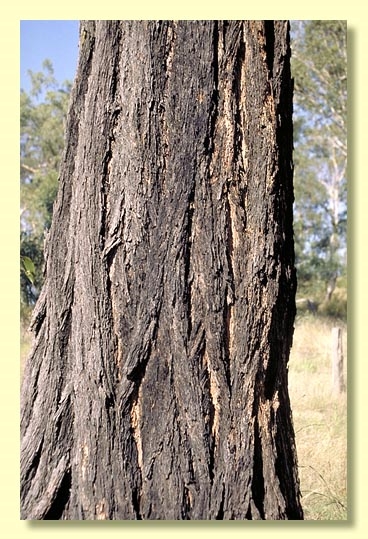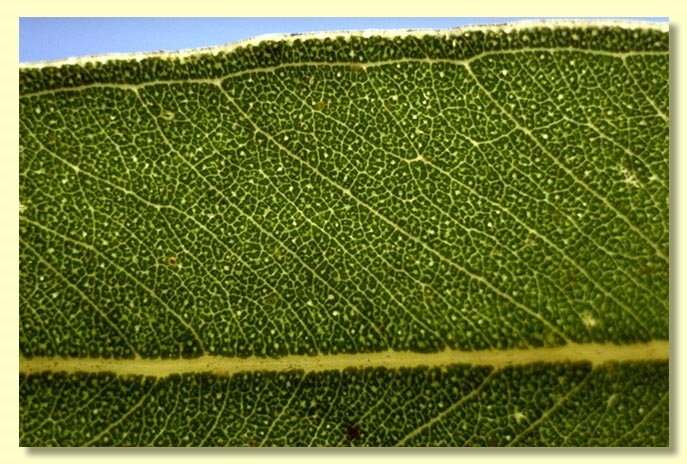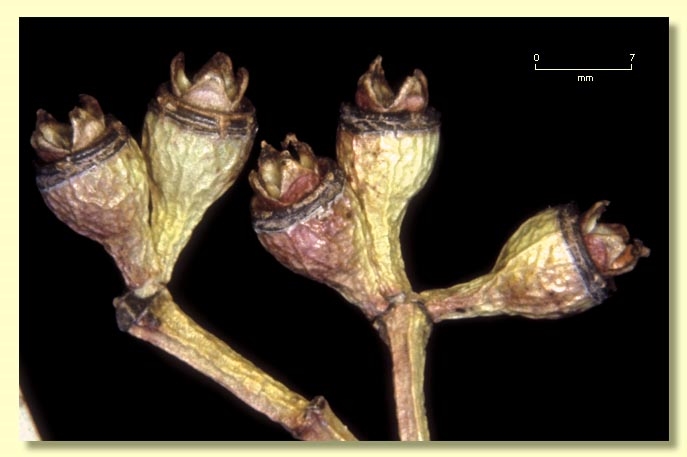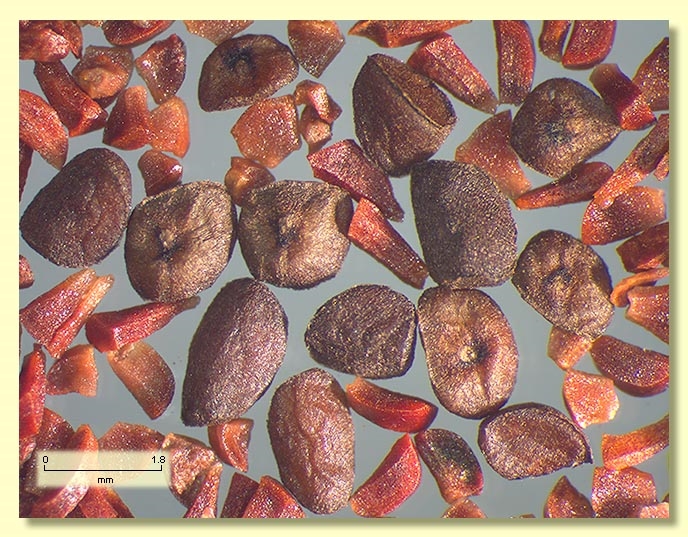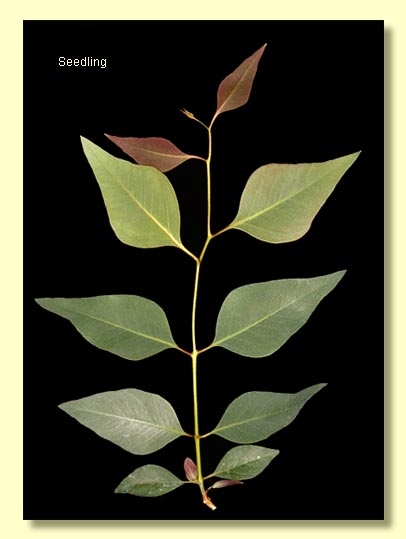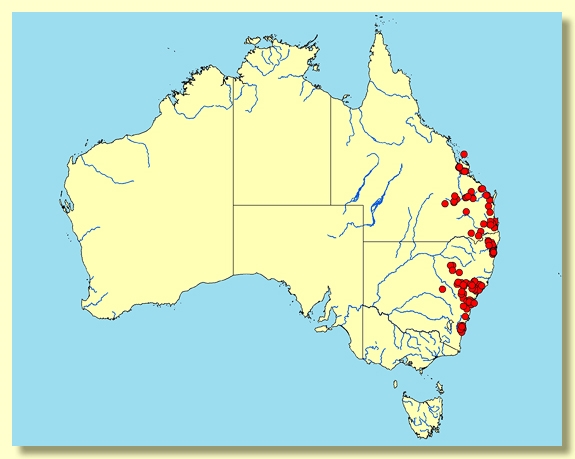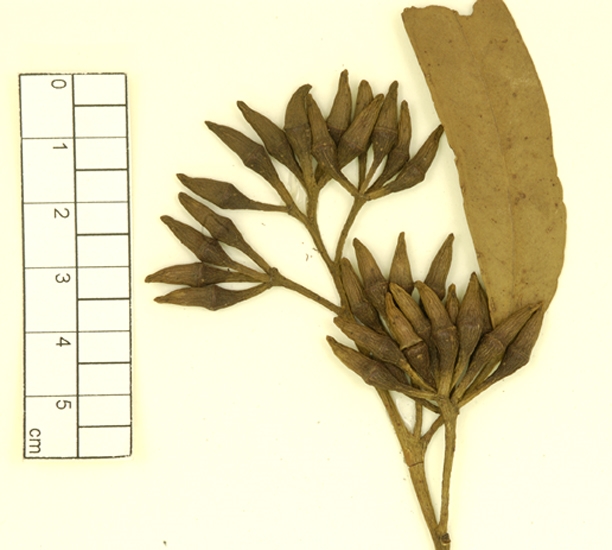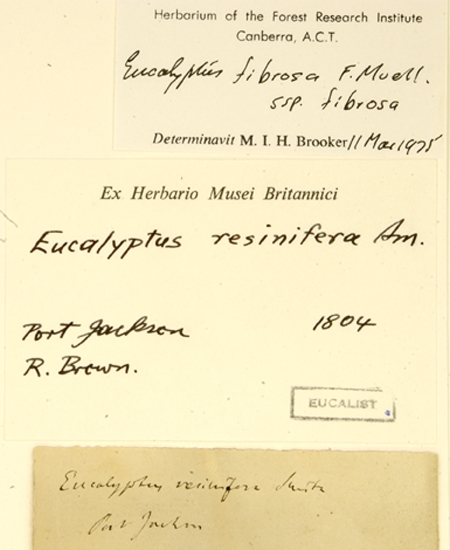Euclid - Online edition
Eucalyptus fibrosa subsp. fibrosa
Eucalyptus | Symphyomyrtus | Adnataria | Apicales | Siderophloiae | Subglaucae
T: near Brisbane R., Qld, F.Mueller; holo: MEL; iso: K.
Eucalyptus siderophloia var. (?)rostrata Benth., Fl. Austral. 3: 220 (1867). T: Port Jackson, NSW, R.Brown s.n.; syn: CANB, K; Port Jackson, N.S.W, G.Caley s.n.; syn; Maitland, N.S.W, J.Backhouse s.n.; syn: K.
Ironbark throughout, hard or soft, sometimes flaky, grey, black, grey-brown; oil glands sometimes present in pith of branchlets.
Juvenile growth (coppice or field seedlings to 50 cm): stem rounded or square in cross-section; juvenile leaves always petiolate, opposite for 3 to 5 pairs then alternate, ovate to orbicular or deltoid, 8–20 cm long, 4.5–14 cm wide, slightly discolorous, slightly glossy, green to grey-green.
Adult leaves alternate, petiole 1.3–3 cm long; blade ovate to broadly lanceolate or lanceolate, 8.5–20.5 cm long, 1.5–4.5 cm wide, base tapering to petiole, concolorous, slightly glossy or dull, green to grey-green, side-veins greater than 45° to midrib, densely to very densely reticulate, intramarginal vein parallel to and just within margin or well-removed from it, oil glands mostly intersectional or obscure.
Inflorescence terminal compound, peduncles 0.9–2 cm long, buds 7, 9 or 11 per umbel, pedicels 0.2–0.8 cm long. Mature buds fusiform to elongated diamond-shaped, 0.8–1.7 cm long, 0.3–0.5 cm wide, yellow, scar present, operculum conical to horn-shaped, stamens erect or irregularly flexed, anthers adnate, globoid, dehiscing by lateral pores or slits, style long, stigma blunt or tapered, locules 3 to 5, the placentae each with 4 vertical ovule rows. Flowers white.
Fruit pedicellate (pedicels (0)0.2–0.6 cm long), obconical, 0.5–1 cm long, 0.5–1 cm wide, often slightly ribbed longitudinally, disc raised-convex or level, valves 3 to 5, slightly exserted or near rim level.
Seeds brown or grey, 1.5–2 mm long, flattened-ovoid, dorsal surface usually shallowly reticulate, hilum ventral.
Cultivated seedlings (measured at ca node 10): cotyledons oblong to reniform; stems rounded or square in cross-section; leaves always petiolate, opposite for 2 to 6 nodes then alternate, ovate, 5.5–15 cm long, 3–8 cm wide, base tapering, apex pointed, slightly glossy, grey-green to green.
Flowering has been recorded in January, March, April, May, June, September, November and December.
Eucalyptus fibrosa is a medium-sized to tall ironbark tree species, widespread on the coast and tablelands and adjacent inland areas of New South Wales and south-east Queensland. It grows in two, more or less, disjunct areas, the first area from just south of Batemans Bay on the south coast of New South Wales, north through the Mittagong, Penrith, Singleton, Glen Davis, Goulburn River area just west of Sydney, as far west as the Hervey Range, Baradine State Forest and Pilliga State Forest areas of New South Wales. The second area starts just south of Grafton on the north coast of New South Wales and extends north through the coastal and hinterlands areas to the Brisbane–Inglewood–Yetman region of southern Queensland and northern New South Wales, as far north as the Shoal Water Bay area just north-west of Rockhampton. From here it extends further inland in a south-westerly direction into the Eidsvold–Cracow–Taroom–Mitchell region of Queensland. It differs from all the co-occurring ironbark species by its relatively broad, concolorous adult leaves, its broad juvenile leaves, the large buds and fruit and the long narrow conical to horn-shaped operculum. It is notable in the ironbarks for the bark which may be somewhat flaky rather than hard.
Within its area of occurrence, E. fibrosa could be confused with E. siderophloia, E. rhombica, E. decorticans, E. beaniana, E. tholiformis, E. taurina, E. crebra and E. ophitica. All belong to the group of ironbarks where all the stamens are fertile and irregularly flexed. They can be separated from E. fibrosa by normally having smaller buds and fruit, rounded to conical opercula (which are always much shorter than the long conical to horn-shaped opercula of E. fibrosa). Another co-occuring ironbark is E. melanophloia. It has a crown of opposite, sessile, juvenile, glaucous leaves. All other ironbark species within its area of occurrence belong to another group of ironbarks which have some infertile outer stamens (staminodes), which can be seen in flower or by dissecting a bud.
There are two subspecies:
E. fibrosa subsp. fibrosa
Occurs over the whole range of the species distribution and has non-glaucous buds and fruit.
E. fibrosa subsp. nubilis
More sporadic and often to the western, climatically drier side of the species distribution. In New South Wales it occurs north from the Gungal–Dubbo area to the Yetman region. It continues across the border into Queensland, from Inglewood north to the Taroom–Cracow–Mitchell region. It differs by the glaucous buds and fruit.


